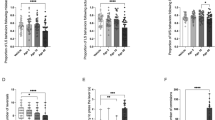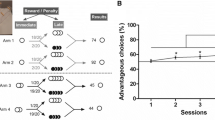Abstract
Benzodiazepines, used in the clinic as anxiolytics, have in animal models been found specifically to attenuate behavioural suppression caused by response contigent aversive stimuli, non-reward or novelty. The effects have been interpreted in more general terms as “behavioural disinhibition” or “response perseveration” or in more specific terms as reduced “reward delay” or as an attenuation of a “behavioural inhibition system”. In a recent publication we have described an experimental test in which decision making in the rat can be studied. The model is derived from ethology, in particular from optimal foraging theory. In order to solve the task, the animal must choose correctly between two options. For each option the probability of its resulting in a reward (water) has to be estimated on the basis of available information and to be related to the cost of performing it. We found that diazepam, in a dose that did not significantly affect the ability to perform the options per se, caused a strong impairment when these options, on the basis of available information, had to be combined into functional sequences in a decision making procedure. The results obtained cannot be explained on the basis of disinhibition or response perseveration. The hypothesis is advanced that benzodiazepines alter decision making in a more nonspecific may, by, for example, affecting the evaluation of the learned significance of stimuli in the environment.
Similar content being viewed by others
References
Cooper SJ (1982) Benzodiazepine mechanisms and drinking in the water-deprived rat. Neuropharmacology 21:775–780
Cooper SJ (1983) GABA and endorphin mechanisms in relation to the effects of benzodiazepines on feeding and drinking. Prog Neuropsychopharmacol Biol Psychiatry 7:495–503
Cooper SJ, Francis RL (1979) Water intake and time course of drinking after single or repeated chlordiazepoxide injections. Psychopharmacology 65:191–195
Dantzer R (1977) Behavioural effects of benzodiazepines: a review. Biobehav Rev 1:71–86
Falk JL, Burnidge GK (1970) Fluid intake and punishment-attenuating drugs. Physiol Behav 5:199–202
File SE (1984) Behavioural pharmacology of benzodiazepines. Prog Neuropsychopharmacol Biol Psychiatry 8:19–31
Geller I, Seifter J (1960) The effects of meprobamate, barbiturates, d-amphetamine and promazine on experimentally induced conflict in the rat. Psychopharmacologia 1:482–492
Geller I, Kulak JT, Seifter J (1962) The effects of chlordiazepoxide and chlorpromazine on a punishment discrimination. Psychopharmacologia 3:374–385
Gray JA (1978) The neuropsychology of anxiety: a synopsis of the 1977 Myers Lecture. Br Psychol Soc 31:33–35
Gray JA (1981) Anxiety as a paradigm case of emotion. Br Med Bull 37:193–197
Gray JA (1982) Precis of the neuropsychology of anxiety: an enquiry into the functions of the septo-hippocampal system. Behav Brain Sci 5:469–534
Haefely WE (1978) Behavioural and neuropharmacological aspects of drugs used in anxiety and related states. In: Lipton MA, DiMascio A, Killam KF (eds) Psychopharmacology: a generation of progress. Raven, New York, pp 1359–1374
Knowler WC, Ukena TE (1973) The effects of chlorpromazine, pentobarbital, chlordiazepoxide and d-amphetamine on rates of licking in the rat. J Pharmacol Exp Ther 184(2):385–397
Lippa AS, Klepner CA, Yunger L, Sano MC, Smith WV, Beer B (1978) Relationship between benzodiazepine receptors and experimental anxiety in rats. Pharmacol Biochem Behav 9:853–856
Ljungberg T (1987) Blockade by neuroleptics of water intake and operant responding for water in the rat: Anhedonia, motor deficit or both? Pharmacol Biochem Behav 27 (in press)
Ljungberg T, Enquist M (1986) Decision making by rats in an unpredictable laboratory, environment — final decision rules. Anim Behav 34:1120–1128
Ljungberg T, Ungerstedt U (1978a) A method for simultaneous recording of eight behavioural parameters related to monoamine neurotransmission. Pharmacol Biochem Behav 8:483–489
Ljungberg T, Ungerstedt U (1978b) Classification of neuroleptic drugs according to their ability to inhibit apomorphine induced locomotion and gnawing: evidence for two different mechanisms of action. Psychopharmacology 56:239–247
Ljungberg T, Ungerstedt U (1985) A rapid and simple behavioural screening method for simultaneous assessment of limbic and striatal blocking effects of neuroleptic drugs. Pharmacol Biochem Behav 23(3):479–483
Maickel RP, Maloney GJ (1973). Effects of various depressant drugs on deprivation-induced water consumption. Neuropharmacology 12:777–782
Nakatsuka I, Shimizu H, Asami Y, Katoh T, Hirose A, Yoshitake A (1985) Benzodiazepines and their metabolites: relationship between binding affinity to the benzodiazepine receptor and pharmacological activity. Life Sci 36:113–119
Nicholson AN, Wright CM (1974) Inhibitory and disinhibitory effects of nitrazepam, diazepam and flurazepam hydrochloride on delayed matching behaviour in monkeys (Macaca mulatta). Neuropharmacology 13:919–926
Saghal A, Iversen SD (1978) The effects of chlordiazepoxide on a delayed pair of comparison task in pigeons. Psychopharmacology 59:57–64
Sanger DJ, Corfield-Sumner PK (1979) Schedule-induced drinking and thirst: a pharmacological analysis. Pharmacol Biochem Behav 10:471–474
Sepinwall J, Cook L (1978) Behavioural pharmacology of antianxiety drugs. In: Iversen LL, Iversen SD, Snyder SD (eds) Handbook of psychopharmacology, vol. 13. Plenum, New York, pp 345–393
Soubrie P, Simon P, Boissier JR (1975) Newer or more operational models and/or methods for studying antianxiety drugs in animals. In: Boissier JR, Hippius H, Pichot P (eds) Neuropsychopharmacology. Excerpta Medica, Amsterdam, pp 720–728
Soubrie P, De Angelis L, Simon P, Boissier JR (1976) Effects des anxiolytiques sur la prise de boisson en situation nouvelle et familière. Psychopharmacology 50:41–45
St»hle L, Ungerstedt U (1986) Differential behavioural patterns induced by the dopamine agonist apomorphine analysed by multivariate statistics. Pharmacol Biochem Behav 24:291–298
Thiebot M-H, Soubrie P (1983) Behavioural pharmacology of the benzodiazepines: In: Costa EMD (ed) The benzodiazepines; from molecular biology to clinical practice. Raven, New York, pp 67–92
Thiebot M-H, Soubrie P, Simon P, Boissier J-R (1976). Spécificité d'action des tranquillants mineurs dans le test de l'escalier relation entre ces effects et leurs propriétés anxiolytiques. J Pharmacol 7(1):87–102
Thiebot M-H, LeBihan C, Soubrie P, Simon P (1985a) Benzodiazepines reduce the tolerance to reward delay in rats. Psychopharmacology 86:147–152
Thiebot M-H, Soubrie P, Simon P (1985b) Is delay of reward mediated by shock-avoidance behavior a critical target for antipunishment effects of diazepam in rats? Psychopharmacology 87:473–479
Treit D (1985) Animal models for the study of anti-anxiety agents: a review. Neurosci Biobehav Rev 9:203–22
Vogel JR, Beer B, Clody DE (1971) A simple and reliable conflict procedure for testing anti-anxiety agents. Psychopharmacology 21:1–7
Wise RA, Dawson V (1974). Diazepam-induced eating and lever pressing for food in sated rats. J Comp Physiol Psychol 86(5):930–941
Author information
Authors and Affiliations
Rights and permissions
About this article
Cite this article
Ljungberg, T., Lidfors, L., Enquist, M. et al. Impairment of decision making in rats by diazepam: implications for the “anticonflict” effects of benzodiazepines. Psychopharmacology 92, 416–423 (1987). https://doi.org/10.1007/BF00176471
Received:
Revised:
Issue Date:
DOI: https://doi.org/10.1007/BF00176471




